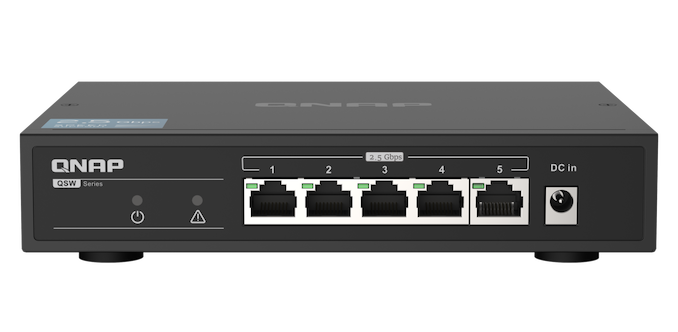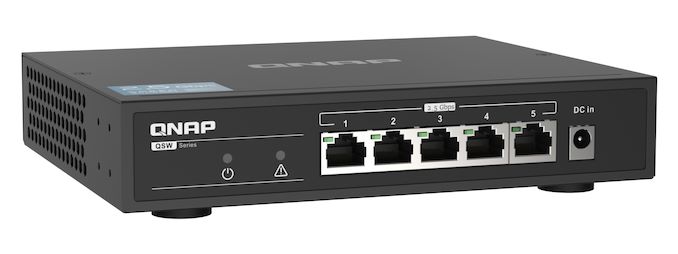At Last, a 2.5Gbps Consumer Network Switch: QNAP Releases QSW-1105-5T 5-Port Switch
by Ryan Smith on July 17, 2020 11:30 AM EST- Posted in
- Networking
- QNAP
- NBASE-T
- 2.5GBase-T
- Ethernet
- 2.5 GbE

After entirely too long of a delay, the wait for faster consumer-grade network switches appears to be coming to an end. This week QNAP launched its QSW-1105-5T switch, one of the industry’s first unmanaged 2.5Gbps (2.5GBASE-T) switches. The 5-port switch supports 2.5GbE operation on all five of its RJ45 Ethernet ports, and along with being unmanaged it is also fanless, allowing the switch to work maintenance-free and installed virtually anywhere. The QSW-1105-5T is already on sale in Taiwan for roughly $100, meaning that we’re looking at a price-per-port of about $20.
The saga of NBASE-T has been something of a long one. First introduced in 2016, the standard added the then-new 2.5GBASE-T and 5GBASE-T modes, which were designed to offer a series of intermediate steps between the existing 1Gbps (1000BASE-T) and 10Gbps (10GBASE-T) standards. By scaling down parts of the 10GBASE-T spec, the new standards would allow more modest – but still many times faster – network transmission rates than 1Gbps Ethernet, all the while being able to reuse existing Cat5e and Cat6 cabling. Overall, 2.5GBASE-T allows for 2.5Gbps Ethernet over Cat5e at the same 100m distances as 1Gbps Ethernet, while 5GBASE-T allows for 5Gbps speeds over 100m runs of Cat6, as well as quasi-official support for shorter Cat5e runs.
Given the technology reuse, moderately-priced NBASE-T network cards were quick to hit the market. However affordable switches have been a more complex matter: while the high initial price of NBASE-T was easy enough to eat on a single controller, multiplied over several ports on a switch, it quickly drove up the price tag. As a result, the market for NBASE-T switches has largely between split between downgraded pro gear like Netgear’s $70-per-port XS505M, and mixed-port switches like Asus’s XG-U2008, which offer just two 10G/NBASE-T ports along with a slew of Gigabit Ethernet ports. So cheap NBASE-T networking options have remained elusive, at least until now.
Thankfully, in the last year we’ve finally started seeing the slower of the NBASE-T modes, 2.5GBASE-T, sprint towards wide adoption. The 2.5Gbps standard is the cheapest to implement, and with recent controller releases from the likes of RealTek and Intel, 2.5Gbps controllers have quickly become a staple on high-end motherboards. Accordingly, with the price per port coming down for 2.5Gbps controllers, it’s also bringing down the price of whole switches. And this is where QNAP’s new switch comes in.
The QSW-1105-5T is one of the first switches to be released using these new generations of cheap controllers. Aimed squarely at the home and SMB markets, the switch doesn’t offer any frills such as network management, Power over Ethernet, or SFP+ ports. Instead it focuses on the things that matter for the home market: supporting 2.5Gbps networking in a small, passively-cooled switch that’s suitable to be neglected by being tucked under a desk or in a closet.
| QNAP QSW-1105-5T Switch | |
| Speeds | 100M/1G/2.5G |
| Ports (RJ45) | 5 |
| Managed | No |
| Power | 12 W |
| Dimensions | 3.4 x 18 x 14.5 cm |
| Cooling | Passive (Fanless) |
| Price | ~$100 |
As the first of what will undoubtedly be many 2.5G switches over the coming months, the QSW-1105-5T also gives us our first real look at what we can expect from this generation of switches as far as footprints and power consumption goes. Since it’s not carved from a pro-grade switch, the 18 cm x 14.5 cm switch is significantly smaller than earlier NBASE-T switches. And with a maximum power consumption rating of 12 W, we’re looking at power consumption of just a bit over 2 Watts per port, which is also a significant improvement over admittedly far more powerful switches.
All of which sounds unremarkable, and indeed that’s exactly what makes the QSW-1105-5T so interesting. The biggest barrier to wide consumer adoption over the last few years has been the cost – both in regards to the core technology and added frills – so we’ve been waiting for quite a while to see NBASE-T technology transition from pro-grade switches to cheap, consumer-grade gear.
Otherwise, QNAP’s new switch is further evidence that the PC industry is going to coalesce around 2.5Gbps Ethernet for the time being. Besides being the fastest standard to officially and fully support Cat5e cabling – which was installed in walls en masse when home networking first took off – it’s also the cheapest and lowest-power option. This is allowing it to be widely deployed not only in new motherboards and cheap USB adapters, but finally in switches as well – and making QNAP’s new switch a good match for all of those new NICs. And while I’d like to see cheaper 5Gbps and 10Gbps gear as well, 5GBASE-T seems likely to remain a premium (if not niche) option, owing to the higher controller costs as well as its higher power consumption, both of which remain big problems for a switch.
At any rate, QNAP’s 2.5Gbps switch is on sale now in Taiwan. The company has not announced release dates elsewhere, but judging from some of their previous product releases, I’d expect it to start showing up in North America some time in the next few months.
Source: QNAP

















98 Comments
View All Comments
extide - Friday, July 17, 2020 - link
You can always build yourself a pfSense box with faster ports.Catalina588 - Friday, July 17, 2020 - link
Comcast's latest third-gen Xfi router has three gigabit ports and a 2.5Gb port. So the 2.5Gb solution to the Internet is now in place and coming to market. All good news. https://www.xfinity.com/support/articles/broadband...cbm80 - Friday, July 17, 2020 - link
also AT&T's latest router has a 5gb LAN port (of course also 2.5g capable).rhysiam - Sunday, July 19, 2020 - link
"Comcast's latest third-gen Xfi router has three gigabit ports and a 2.5Gb port"Wait - so you can only use your >1Gbps Internet connection if you spread the load over several ports? Each single host is limited to 1Gb? That's not a good solution at all! I suppose it's better than a 1Gbps router, but still, that seems like a huge limitation to me.
lmcd - Sunday, July 19, 2020 - link
I assume one of the ports (unmentioned) is a coax that supports the needed bandwidth.romrunning - Friday, July 17, 2020 - link
A few of the more expensive routers have them - for example, the Netgear Nighthawk AX12 has a single 5/2.5/1GBe port along with 4 1GBe ports. I'd pay an extra $100 to get all the ports with 5/2.5/1GBe.Well, what I would rather have is a 4-stream only router with all 5/2.5/1 ports for much less than the 12-stream AX12. So Netgear's $100 basic model, but with all 5/2.5/1 ports, for a total of $200. I'd buy that right away!
Brett Howse - Friday, July 17, 2020 - link
There are routers with 2.5 GbE as well. We have one for the laptop test bed:https://www.anandtech.com/show/15485/at-101-wifi-6...
Plus as others have stated it's not always about WAN performance. You can be easily bottlenecked on the LAN with just 1 GbE these days.
Jorgp2 - Friday, July 17, 2020 - link
Why?Might as well go full 10G ports on your router, since it will only have a few interfaces. There are already many 10G router out there.
Makaveli - Friday, July 17, 2020 - link
If they released one of these with a SFP+ port that can sync 10/5/2.5/1Gbe and network management I would buy it for about $250!xplorn - Friday, July 17, 2020 - link
So the Mikrotik CRS312-4C+8XG-RM seems like a good deal. They also have a 4pt SFP+ switch. The S+RJ10 transceiver is multigig.